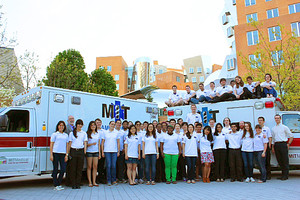Engineering the MIT Ambulance
By Ken Gagné
MIT students rely on cutting-edge technology to do coursework and research, and the student-led Emergency Medical Services (EMS) team is no different. So when it came time for the group to purchase a new ambulance, they did what MIT students do best: they designed it themselves—from scratch. The result was not only a state-of the art emergency vehicle, but what MIT-EMS Technical Director Mark Forgues calls "the single most comfortable vehicle I have ever ridden in the back of."
The previous ambulance, purchased in 2003, had served the team well. But its outdated technology and physical constraints were becoming apparent, and EMTs had become frustrated with the limited maneuverability it provided to attend to patients.
In 2011, the team began envisioning their next-generation ambulance. And as the ones who would be using the ambulance, the students felt they were best-suited to define its capabilities. For inspiration and guidance, they conducted teleconferences with leading global safety experts and went on site visits to see other EMT teams' ambulances.
To plan the layout of the new ambulance, the MIT EMTs appropriated a basement room at MIT Medical, demarcating the ambulance's perimeter on the floor with masking tape. They substituted boxes for seats, stretchers, and cabinets.

MIT-EMS ambulances
The MIT-EMS crew with ambulances old and new, simultaneously in service for just a single day. Photo by Jennie Choe.
"We tried to follow a European model," says Forgues, referring to European Union ambulance specifications, which have a heightened focus on operator safety. For example, the old ambulance configuration prevented EMTs from wearing a seat belt while caring for a patient; EMTs had to balance a patient's needs against the potential risk of riding unrestrained. "The least we can do is make their job as safe as possible," says Forgues.
"We designed the ambulance around safety," agreed biology major Dylan Soukup, '14, current MIT-EMS chief. "We knew we wanted five-point harnesses, seats that swiveled, equivalent storage on either side of the stretcher, and other essentials. We went feature-by-feature."
After six months, it was time to turn the blueprints into reality, a task that had its own challenges, Forgues says. "A number of major manufacturers wouldn't even bid on it," he explains, due to the ambulance's unusual dimensions and customizations. Eventually, Braun Ambulances accepted the challenge, taking eight months to complete the build. Braun used their 23-foot Chief XL chasis as the basis for the new ambulance—leaving just 10 inches of wiggle room in the MIT-EMS ambulance bay.
Notable among the vehicle's safety features is a lack of "strike zones" —any protrusion that could cause an EMT to hit his or her head while working. Video displays are embedded flush with the wall, and eye-level cabinets have been replaced with drawers with magnetic seals. Not only do the drawers not accidentally open as the ambulance turns a corner, but their contents are more accessible than a cabinet's, in which items in the front may obscure objects behind. Some supplies are accessible from the ambulance's exterior, as well, relieving EMTs from needing to reenter the ambulance to retrieve necessities while attending to a patient outside. Dome lights have been replaced with LED panels, improving the vehicle's visibility. The innovations continue in the driver's seat, where side and reverse cameras and a GPS unit help navigate to any emergency.
The improvements this unique, unparalleled ambulance brings to EMTs is evident beyond the MIT community. In October, the Metropolitan Boston Emergency Medical Services Council recognized MIT-EMS with an Innovation of the Year Award for "innovative thinking to address a problem that affects the EMS community." Forgues isn't surprised: "It's tight, it drives beautifully, and it handles great," he enthusiastically notes.
But there's more to the ambulance than its industry recognition, as it bears personal significance to its crew, as unveiled at the vehicle's christening. MIT Medical's manager of budget analysis & purchasing, Gloria Raymond, called the Massachusetts Registry of Motor Vehicles (RMV) and requested license plate number 179 to honor the late Sean Collier, the MIT police officer who was killed in the line of duty last April. Collier's badge number was 179. Upon hearing what this number meant to the MIT Medical community, the RMV released it for use on the ambulance. A graphic on the side of the ambulance also commemorates the Collier.
From the design to the build to the dedication, the MIT community now has an ambulance that reflects its creativity and values. But future classes of MIT students will also get an opportunity to leave their mark on the EMT fleet. The average lifespan of an ambulance is less than ten years, so in 2021, it'll be time to start designing the next generation of ambulance.

